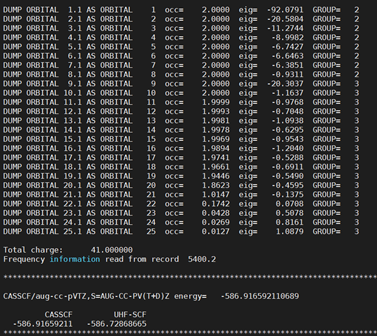CASSCF single point lead to different results
63 views
Skip to first unread message
Jing chen
May 17, 2021, 7:09:44 AM5/17/21
to molpro-user
Hi all,


I'm running some multireference calculations using Molpro2020.2 and run into a problem.
I first did a CASSCF TS optimization, find the corrected TS with the desired imaginary frequency.
Then I took the optimized TS geometry, did a CASSCF single point, define the active space in the same way as the optimization. But the single point leads to different energy than the optimization endpoint. The frequency analyses on the single point also have a different result.
My guess is that the single point used different orbitals than the optimization in the active space.
The natural orbitals from the optimization look like:

The natural orbitals from the single point look like:

The orbital 9.1 from the single point calculation, which is obviously a core orbital, corresponding to the orbital 2.1 from the optimization. Seems the natural orbitals are sorted by the occupation number, and the orbital 9.1 from the single point only has an occupation of 1.99998, while orbital 2.1 from the optimization has an occupation of 2.00000.
This difference in the orbital order will have an effect on the subsequential calculations. Are there any suggestions on how to solve this?
Thanks a lot for your time!
Best regards,
Jing
Tony Stüker
May 17, 2021, 8:01:29 AM5/17/21
to molpr...@googlegroups.com
Hi Jing,
In C1 symmetry there is only one way to avoid this: reduce the
size of your active space. Exclude those orbitals that have
occupations close to 2, I would try declaring all orbitals
<1.99 as closed, i.e. "closed,16".
Good luck and kind regards
Tony
--
You received this message because you are subscribed to the Google Groups "molpro-user" group.
To unsubscribe from this group and stop receiving emails from it, send an email to molpro-user...@googlegroups.com.
To view this discussion on the web, visit https://groups.google.com/d/msgid/molpro-user/376b8f0d-da5d-46c0-bda9-59b5aaf5070dn%40googlegroups.com.
-- Tony Stüker, M.Sc. AG Riedel - Halogenchemie Freie Universität Berlin Institut für Chemie und Biochemie - Anorganische Chemie Fabeckstr. 34-36 14195 Berlin GERMANY Tel.: +49 (0)30 838 59158 Mail: tony.s...@fu-berlin.de
Tony Stüker
May 17, 2021, 8:01:38 AM5/17/21
to molpr...@googlegroups.com
Another way: Or you could take the converged orbitals from your TS calculation as start orbitals, if the method (basis set) is identical, it should be converged after the first iteration to the same result.
Best wishes
On 17.05.21 10:40, Jing chen wrote:
--
You received this message because you are subscribed to the Google Groups "molpro-user" group.
To unsubscribe from this group and stop receiving emails from it, send an email to molpro-user...@googlegroups.com.
To view this discussion on the web, visit https://groups.google.com/d/msgid/molpro-user/376b8f0d-da5d-46c0-bda9-59b5aaf5070dn%40googlegroups.com.
Jing chen
May 18, 2021, 3:29:34 AM5/18/21
to molpro-user
Hi Tony,
Restore the orbitals from the optimization solved the problem.
Thanks a lot!
Best regards,
Jing
Reply all
Reply to author
Forward
0 new messages
